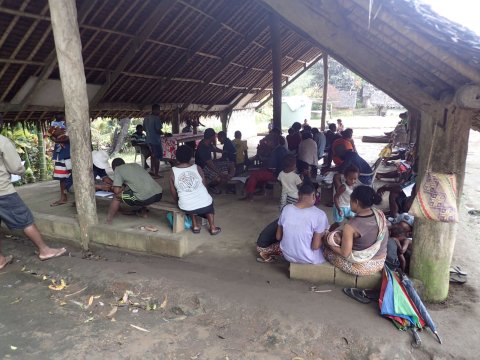Studying mental health after disaster-related displacement in the South Pacific

Kathryn Olszowy is Assistant Professor of Anthropology at New Mexico State University. Kelsey Dancause is Associate Professor in Physical Activity Sciences at the University of Quebec in Montreal.
Population displacement is common and increasing. As of mid-2019, the World Health Organization estimates that 65 million people are forcibly displaced around the globe. Most of these are in low- and middle-income countries (LMICs). Displacement can be highly stressful, which can affect long-term mental health.
Unfortunately, the countries where displacement is most common are often those with the least infrastructure for mental health interventions. As climate change and natural disasters force ever larger numbers of people in LMICs from their homes, studies of mental health following disaster-related displacement are urgently needed.
The Ambae community health study
The stresses associated with natural disaster exposure and displacement are well known. Both displacement and natural disaster exposure are associated with increased anxiety, depression and distress. However, our most complete studies are from high-income countries.
Outcomes might be different in LMICs, where mental health services are often limited and might be further weakened due to disaster. The relative lack of research in LMICs complicates the development of interventions and the direction of aid resources to communities and individuals in need.
In October 2017 in Vanuatu, a lower-middle income country of 280,000 people in the South Pacific, high levels of volcanic activity on rural Ambae Island forced the evacuation of the island’s entire population of 10,869 people. Flying rocks, acid rain and ashfall damaged homes, gardens and water supplies, and prompted fears of imminent eruption.
Displaced families moved to neighbouring islands, with no certainty as to whether the volcano would erupt, when or if they could return, and how their homes, gardens, and livestock would be affected.
Despite limited mental health infrastructure, the Vanuatu Ministry of Health worked quickly to organise a mental health intervention response for the displaced individuals. A small team was sent to provide psychosocial support in the form of professionally-led group discussions and individual psychological first aid in some displacement camps.
This response was the first of its kind in Vanuatu, and although modest, it represents an important step in integrating mental health into disaster response and recovery plans.
We worked with the Vanuatu Ministry of Health to study psychological distress among adults from the displaced communities. Our goals were to characterise distress in the displaced population, to characterise the psychosocial support they received and to identify characteristics of people at high risk of distress.
Ultimately, studies like these could help officials in Vanuatu and in other LMICs to better direct their limited resources and to more efficiently intervene following disaster-related displacement.
How was the study conducted?
After being displaced for up to two months, volcanic activity decreased and some families began to return to Ambae. Thus, between November and December 2017, we surveyed communities around the island to study mental health outcomes of individuals who had returned, and their experiences of displacement.
We collected self-completed questionnaires from 479 adults (226 men and 253 women) from 13 villages across the north, south, east and west regions of the island. The questionnaire included questions on experiences such as food and housing security, distress, and psychosocial support during displacement.
The type of psychosocial support received varied among individuals and fell into four general categories. First, more than half of the people in our survey sought support from healthcare professionals, including the support groups organised by the Ministry of Health.
Another 18% of participants did not receive support from healthcare professionals, but received support from traditional healers, pastors and other traditional community support mechanisms.
A small percentage of people (4%) received no support because it was not wanted. Finally, 21% of participants reported that psychosocial support – either through professional or traditional support networks – was not available. Characterising these four support types allowed us to compare psychological distress among groups.
What were the most important findings?
We found that women experienced greater distress than men. This finding is similar to other studies of distress following natural disasters in other countries. This indicates that women are at greater risk during disaster-related displacement, information which can help target future interventions.
We also found that, among women, distress varied based on the type of psychosocial support received. Levels of distress were similar among women who received health professional or traditional support, and also among those who did not want support.
However, distress among women who reported no available support was significantly greater than in the other groups, even when controlling for factors such as age, education and number of children.
These findings help to highlight the importance of mental health initiatives like those of the Vanuatu Ministry of Health after the displacement. In countries with very few mental health professionals and little public awareness about mental health intervention, intensive mental health treatment following disasters might not be possible.
On the other hand, training programmes that can equip general health practitioners to conduct small-scale community-based interventions might be promising. The Vanuatu Ministry of Health has increased investment in mental health capacity, including a 2009 policy initiative that trained 63 healthcare workers in mental health support.
The finding that displaced adults used services provided by these healthcare workers is itself promising. Furthermore, many displaced adults continued to rely on traditional support networks, which might point to another avenue for delivering services in the future.
Providing mental health training to individuals outside of the formal health sector, such as traditional healers and pastors, might open up more opportunities for the development of sustainable and culturally relevant mental health intervention.
Finally, given that we found a relationship between (lack of) availability of psychological support and distress in women, this highlights the importance of these kinds of initiatives in population mental health during emergencies.
While we cannot connect outcomes in our study with specific strategies implemented by healthcare professionals or traditional healers, the results show that just increasing the availability of psychological support in affected communities may be an effective way to ameliorate symptoms of distress.
What’s next?
To date, only about half of the Ambae population has returned to their homes. A significant number remain on outlying islands (primarily Santo Island), and few can afford to make the plane or boat ride home. With support from the National Geographic Society, we returned to Ambae during June-July 2019 to conduct a follow-up with families on Ambae as well as on Santo.
Homes and gardens on Ambae were destroyed, and families on Ambae and those who remained on Santo experienced on-going food, housing, and water insecurity. We aim to follow up with these families to investigate long-term impacts on both mental and physical health, including the factors that might buffer individuals from negative outcomes.
This study is an important model that will help us understand the effects of short- and long-term displacement on individuals, families, and communities in the South Pacific, a region of the world that will experience some of the most immediate and significant consequences of global climate change.

